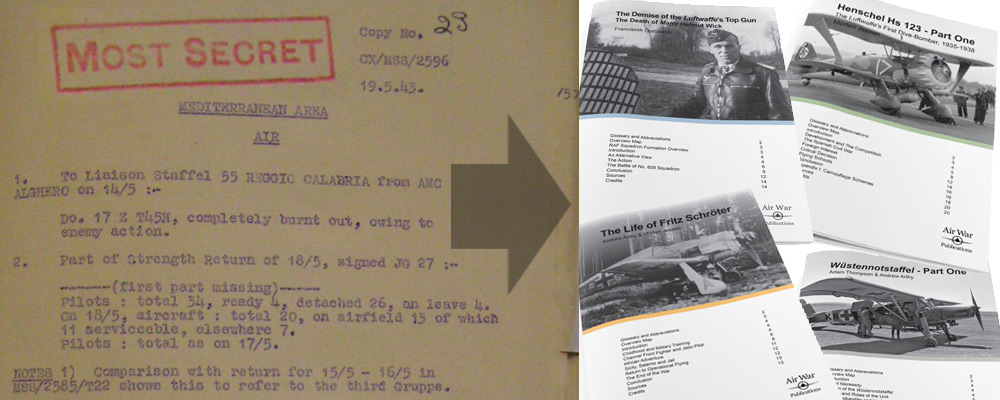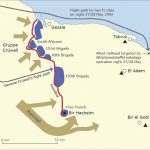The eArticle creation process is not a particularly straightforward one, but here at Air War Publications we’ve now had enough practise to know the best way of going about it. We thought some of our followers and fans might be interested to learn a little more about the work and time that goes in to creating each of the 10-25 page PDF’s.
Topic
First, choose an interesting topic. Here at Air War Publications we tend to steer clear of the more ‘mainstream’ aviation history topics, not because we find them uninteresting, but because there are so many untold stories from the Second World War that we prefer to focus on instead. We have four general categories of eArticles: Frontline, Biography, Unit History, and Aircraft and Camouflage, so there is plenty of scope for stories about all aspects of Second World War aviation.
A topic can be selected in many different ways. Over the years we have been fortunate enough to correspond with and interview numerous pilots from the Luftwaffe, RAAF, RAF and USAAF. These men are, of course, obvious topics for Biography eArticles. However, very often the veterans are able to contribute an interesting first-hand anecdote or a photograph related to a Frontline or Unit History eArticle. Another way that topics are selected is by browsing through archival documents and finding interesting events that suggest themselves as a great candidate for a story. Often, an eArticle will be based on a subject we started researching and writing about a decade or more ago. When we find an interesting topic, we then keep an eye out for potential sources, and as the years go by the story grows and grows. This was the case with the forthcoming 2.(H)/14 eArticle – Adam and Andrew started researching that reconnaissance Staffel as long ago as January 2003!
Sometimes the eArticles are extracts from our book projects, but often they are fascinating subjects that are simply too small to ever be published as books. Thus the eArticles provide us with a valuable outlet for research that would not otherwise see the light of day.
Ultimately, the reason why we are not particularly interested in the ‘mainstream’ topics is that a lot of the detective work has already been done, and the detective work is a main part of the fun for us. Moreover, despite some aviation history topics being labelled as ‘mainstream’ or ‘popular’, there will rarely be much to gain in terms of money, fame, fast cars and women when writing about this subject. Therefore, given that the detective work is the most enjoyable part, why pick topics where most of the fun has already been done?
Research
In order to produce a quality article, we try to cast our research net far and wide. This means we have at the heart of our work documents from archives in Germany, Britain, the United States, Australia, Italy, Russia, and elsewhere. The archival research for a single eArticle can involve searching through thousands of pages to find those key pieces of evidence about a topic. These documents are gathered primarily through our own research trips to the archives, where we use a digital camera to photograph several thousand pages per day, but also through trading files with fellow researchers.
To help avoid our work becoming too dry, a personal touch is provided by documents belonging to airmen and personnel. On the German side this includes Flugbücher (logbooks), Tagebücher (diaries), Wehrpäße and Soldbücher (the last two being military identity documents). We also use the various Allied equivalents for articles featuring the RAF and USAAF. To supplement these sources, we consider well-researched secondary sources. Interviews with veterans provide valuable first-hand accounts, so the reader can get a feel for what it was like to experience the events we describe.
If the article is a biography, or if there are particularly interesting characters, we try to search out veterans (now an almost impossible task) or their families (not so difficult, but still challenging). To find a German veteran, the online phone book is the key: search the surname and see how many people there are in Germany (or Austria) with it. If there aren’t too many, or if they happen to be from the place where ‘our’ man was born or died, we find a postal address or email address and attempt to establish contact. The success percentage is quite low, perhaps ten per cent of correspondence reaches the right family, but only half of those people want to help, and only half again are actually able to help with information, photograph scans, document copies, and the like. However, we’re very grateful to all the Germans and Austrians who kindly reply to us and attempt to help these strangers from foreign lands. It is appreciated!
Photos, Illustrations and Maps
Photographs, aircraft profiles, artwork and maps are important elements in all of our articles. Of course an interesting story can stand on its own, but since we are dealing with history we want to include photos to show what the pilots, machines and surroundings looked like. The degree of difficulty in obtaining the photographs varies. Sometimes we spend months or even years chasing photos of particular people or aircraft, so that they match the particular unit, time period, theatre of war or individual. Fortunately, many fellow researchers are helpful and selflessly share photos and documents from collections they have spent a lot of time and money obtaining. Without these contributions our works would be of a lesser quality.
We’ve previously outlined the mission map creation process (see our blog post here), but that is also an element in our articles that we are focused on. We find it important to set the stage of a story. That is why all our eArticles start out with an overview map, and if necessary, it is followed up by further detail maps and mission maps, highlighting the specifics of a single mission. These maps help the reader to follow the events being described in the story, because after all, a picture is worth a thousand words!
Writing and Layout
Once the research has been done (and it is never fully completed!), the writing process begins. The story starts with a Microsoft Word document, and we’ll pass it back and forth between author (or co-authors) and editor. Using the track changes function, we can see who has done what to the manuscript. This process can be very straightforward, or it can bounce back and forth for months (or years). As the text is nearing completion, if we have an article that explores an area we feel is particularly important, we send it for review by someone considered an expert in the field. Obviously this helps us market the article if they provide favourable comments, but it is also a final bit of quality control, just to make sure we have produced something of the best possible standard.
Sometimes the hard part of writing is trying to decide what to leave out. Often, as a story unfolds new pieces of information will come to light and as authors we think, ‘Great! I really need to add that in …’, but unfortunately we do have to limit our articles to a certain focus, size and length. This is obviously to ensure we are able to supply a steady stream of publications, but also to limit the amount of time and effort everyone involved in the process has to dedicate to the endeavour. For a standalone article, we like to cap the length at around the 6.000 word limit, but for those really juicy topics, we do make exceptions and they give rise to our two-part system. And sometimes we face the opposite challenge – that some information or vital photographs are missing as the last piece of the puzzle. That always requires some creative ways of thinking, and often requires the help of other researchers or collectors.
Layout
With the text finalized, the photos gathered, and the illustrations completed, it is time to put all the elements together using Adobe InDesign. This is a finicky but enjoyable task, and one that Morten has become very adept at over the years. It’s always exciting to see what began as an idea in our heads become a professional-looking document ready for publication.
Publication
And finally, the easy part! Once all the editing is complete, the layout is just right, all maps are included and the photos and their captions are in place, it is as simple as clicking the WordPress publish button and presto – another great eArticle is ready!
Who Can Contribute
The good news is that anyone with a story can write for Air War Publications. It is just a matter of whether the topic has enough depth and can be covered in detail. Often the hardest part is ensuring that there is enough photographic evidence to support the article. The key, however, is patience and dedication. Our eArticles are only this great because our contributors work with us every step of the way. So if you think you have a fascinating Second World War aviation story that you’d love to share, why not drop us a message here.








